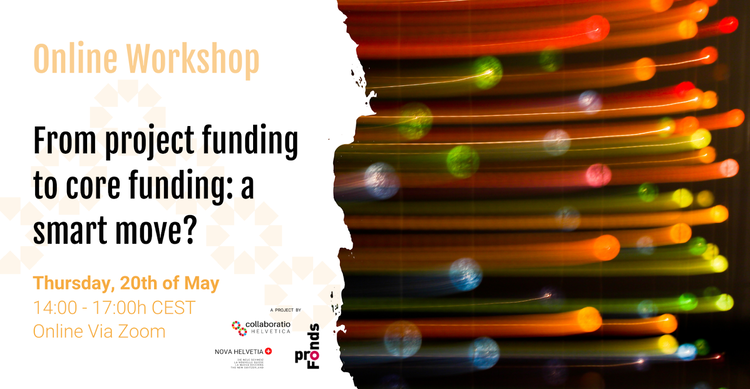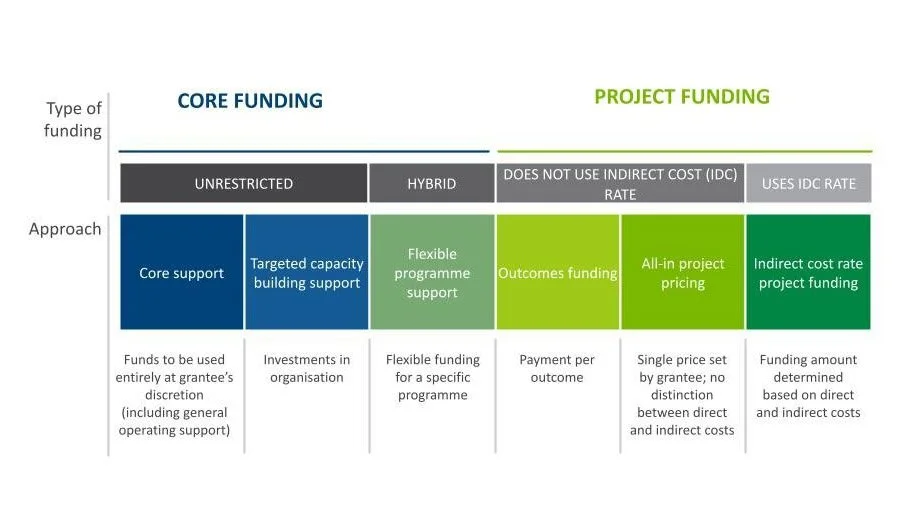From project funding to core funding: a smart move?
Should donor foundations also invest in the infrastructure of non-profit organisations? Over 30 participants from big and small foundations and associations explored this question in a recent online workshop co-hosted by collaboratio helvetica and proFonds. Looking at this topic from both the prism of two donor foundations and from the perspective of one grantee organisation helped participants to gain a deeper understanding of the benefits and possible pitfalls of such funding as well as consider next steps.
At the proFonds Foundation Day in November 2020, Matthias Daberstiel, co-founder of Fundraiser magazine, threw this question into the (virtual) conference room. Intrigued by the resonance it elicited among the public, collaboratio helvetica’s working group on “Funding the future”, together with proFonds Arbeitskreis «Stiftungsmanagement und Projektarbeit», co-hosted an online workshop on 20 May 2021 to look at this issue from various angles and jointly reflect on possible approaches and next steps. The co-hosts were Vanessa von Richter, Violette Ruppanner, Nora Wilhelm, Eva-Maria Spreitzer and Boryana Milova.
Indeed, times are changing fast and so do foundations' and grantees’ needs and practices. However, both sides share the same goal and its accompanying pain, namely How to fund systemic interventions and social change effectively and flexibly while fulfilling the requirements of donor foundations and responding to the needs of grantees?
First, we learned from Adriana Crăciun (Senior Adviser, Oak Foundation) and Simon Mériaux (Organisational Development Manager, MAVA Fondation pour la nature), that - just like in impact investing - there is a continuum of funding types to support grantees and their (impact) projects. These range from entirely unrestricted funding to what is called “indirect cost rate project funding”.
Illustration: Continuum of funding types (adapted from Bridgespan)
Typically, foundations that provide unrestricted and hybrid funding do so because they have realised that investing in organisations and actors in this way provides the latter with more stability, enabling them to plan for the longer term. At the same time, it gives programme and project partners much needed flexibility, improves their responsiveness and strengthens their resilience, all essential features required in today’s VUCA world. More fundamentally, power is shifted towards grantees, incidentally also easing grant processing on the giving side.
Both speakers shared their belief that philanthropy is more successful, rewarding, and effective if grantees and staff relationships are approached based on trust. This fundamental attitude encompasses leading with trust, putting relationships at the centre, collaborating with humility and respect and working for systemic equity.
Jonas Nakonz (Member of executive committee & senior project manager, foraus - Swiss Forum on Foreign Policy) shared his organisation’s experience with developing a core funding facility through a consortium currently comprising four foundations. This pilot experience is to last from 2021 to 2025 and is governed by a memorandum of understanding, joint reporting and twice-yearly meetings. The stated goals are:
to consolidate & scale impact creation of foraus and
to generate shared learnings on core and collaborative funding.
It’s impact is already felt within foraus. In particular, it has increased job security and allowed a greater focus on what matters, shifting energy away from the pursuit of small projects to focusing on the organisation’s core mission. It also has improved impact assessment.
In the ensuing lively conversation, the three input givers shared their thoughts on the possible challenges and pitfalls of unrestricted and flexible funding. These ranged from how to select good candidates for funding, how to shift from focusing on project impact to an organisational perspective, how to measure success to how to ensure full accountability.
For both foundations, full mission alignment between the grantee and the foundation, a strong record of success in prior grants and continued confidence in leadership and vision are prerequisites for unrestricted and flexible funding. Nevertheless, unrestricted funding might also be provided for start-ups that require an injection of capital to meet all contingencies during their incubation phase or for organisations that need assistance, be it because they experience temporary difficulties in their life cycle or need assistance in a period of transition. This funding type might also be appropriate for organisations in the Global South who are often too small to qualify for project grants, but are of sufficient size and programmatic value. Finally, it may also be granted to organisations undertaking controversial projects of interest but that are controversial, thus deflecting association to the controversial element.
In several breakout groups, participants then deepened their understanding of the practices, possible obstacles and challenges on both sides and reflected on how they could bring this topic into their respective organisations and develop it further together.
In conclusion, although allocating unrestricted or flexible funding types is not without its challenges, it creates significant benefits for both giving and receiving organisations if prepared well and executed with care.
Finally, the following possible action steps emerged from our lively discussions:
Create and host regular spaces for stakeholders to raise more awareness and a shared language, explore practices and experiences as well as learn from each other;
Create a working group to build awareness for the practice of unrestricted and/or flexible funding (e.g. with the aim of publishing a manifesto for such practices);
Activate key decision-makers from donor foundations and other relevant actors to prototype such funds, adding diversity to the Swiss funding landscape;
Involve academia to proof the benefits of such practices;
Push the boundaries within one’s own organisation by hosting and inviting meaningful conversations around this topic.
Further literature
Funding organisational development: a smart investment to multiply impact (report, 20 min read)
Core grants: the long and winding road to transformative funding (report, 35 min read)
Funding the Future: the crucial role of foundations (blog post, 3 min. read)
New attitudes, old practices: The provision of multiyear general operating support (report, 30 min. read)
Violette Ruppanner, Senior Partner, Strategos
Eva-Maria Spreitzer, Participatory Researcher and Collaboration Facilitator
The shared intention of the Nova Helvetia working group Funding the Future was to better understand how to activate funding streams to support systems change and the implementation of the 17 Sustainable Development Goals of the United Nations.


